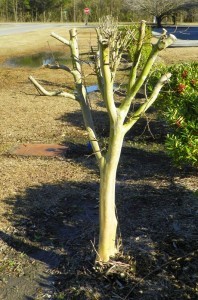Everyone has their own story for how and why to prune crepe myrtles.
But how much of it is actually fact?
Let’s observe:
Pruning methods that promote a sound tree structure help trees resist failure, provide clearance, and improve aesthetics, while promoting long life.
From training young trees to managing mature ones, structural pruning to guide and manage tree architecture should be the primary goal each time a tree is pruned.
A well-structured tree is aesthetically pleasing, preserves the crown as it grows larger, and is long-lived. Poor tree architecture can be costly, leading to failure and early tree removal. When improperly performed, pruning can harm the tree’s health, stability, and appearance and make matters worse.
– University of Florida
Ok, so it is important to prune a tree. I get it, you get it, everyone gets it. But we’re talking about crepe myrtle pruning, right? So what about those?
Like all trees, pruning a crape myrtle involves enhancing its natural form rather than trying to force it to grow in a space that is too small or an artificial shape. Crape myrtles naturally grow as small upright or vase shaped trees with multiple trunks. In a well pruned crape myrtle, the trunks grow upward and outward, with branches fanning out rather than growing inward into the center of the tree.
Remove crossing and inward growing branches.
To determine if your crape myrtle needs to be pruned, examine the direction in which the trunks and branches grow. Starting at ground level, follow the trunks upward to where they begin to branch, focusing on the interior of the tree rather than the outer edges. Branches that grow into the center of the tree, crossing over other branches or trunks, should be removed.
To remove a branch, follow it back to where it joins a larger branch or trunk. Take a close look at the point where the branch joins the trunk. You will notice at the point where the two join the branch is swollen or enlarged. This area is known as the branch collar. Using a pruning saw, remove the branch by cutting just above the branch collar rather than flush with the trunk. If the branch was removed at the correct place the branch collar left behind will extend out a centimeter or two from the trunk.
If it has been years since the tree was last pruned you may have to remove several branches. Whole trunks can be removed by cutting them off as close to ground level as possible, but this results in profuse sprouting of suckers during the summer and should be done only as a last resort.
If you have the time and the tree is not too large, you can clean up the interior of the tree by cutting off small twiggy branches that grow from the main trunks. This is best done using hand pruners. You can also remove seed pods and trim off the ends of branches that are less than pencil sized in diameter. While these practices will help the tree look neater and may increase the size of flower clusters, they are not necessary to keep the tree healthy.
-North Carolina State University.
I don’t think that could be any more well written than it is. Most people see their neighbors outside  clipping away, so happy go lucky, not paying attention to what the sole purpose of pruning actually is. The goal is to preserve the natural shape of the tree – not turn it into a bush. Topping and lopping any and everywhere not only looks ridiculous, but ultimately harms the plant and inhibits bloom production!
clipping away, so happy go lucky, not paying attention to what the sole purpose of pruning actually is. The goal is to preserve the natural shape of the tree – not turn it into a bush. Topping and lopping any and everywhere not only looks ridiculous, but ultimately harms the plant and inhibits bloom production!
Take a look at the picture. If that’s your crepe myrtle, well first I apologize, but secondly, you’re doing it wrong.
So next time you see Mr. Jones out there chainsaw happy commiting Crepe Murder, refer him back to our blog, then laugh, smile, and pour him a beer. He’ll need it all summer long as he watches his unhappy trees under perform… again.
Be sure to contact us if you have any questions about pruning crepe myrtles or any other tree and shrub. And don’t forget our sister company, Top Notch Tree Service! They can walk you through just about anything tree related you might ever need!
Share this Post